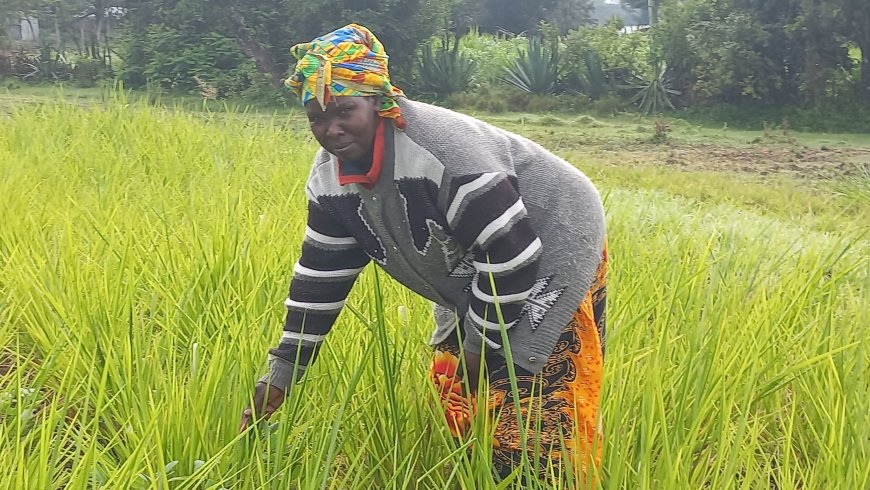Farmers trained on forage production through climate smart innovations

Kiambu,
Sunday, December 10, 2023
KNA Wangari Ndirangu
Over 6,500 farmers in three counties have been trained in the whole production cycle of fodder crops in the last three seasons through the Integrated and Climate Smart Innovations for Pastoralist Economies and Landscape (ICSIAPL) project.
The Project is being implemented by Kenya Agricultural Livestock Research Organization (KALRO) in partnership with the Netherlands Development Organisation (SNV) – Kenya with three counties of Narok, Kajiado and Taita Taveta being the main collaborators.
KALRO’s Arid and Rangeland Research Institute (ARRI) Director Dr Simon Kuria says they trained the farmers for over four months taking them through a whole production cycle of fodder crops, starting from a lot of preparation, the sowing itself, weeding management, the harvesting stage, conservation of the feed material, feeding the animal, up to developing business cases around the fodder production for use by the farmers.
Speaking during a tour in Taita Taveta and Narok Counties where the project has been implemented and working with livestock farmers, Dr Kuria said that since 2021 they have introduced over 20 different fodder crops for the arid in the low and also high rainfall areas.
“This project came to address the problem of feed scarcity in this country. The Cost of feed constitutes between 70 and 75 percent and is usually high. If the farmers cannot reduce the cost of feed it then becomes very difficult for the farmers to make any money for their dairy and beef production”, he said.
Dr Kuria said the three year Sh 53 million funded project by the European Union is now almost coming to the tail end and whose overall goal was to use research innovations to improve livestock productivity and by doing so improve the livelihoods of the people and build their resilience against climate change.
“During the project we established demonstration plots that were used as training centres for the farmers and each demonstration plot had about 10 to 12 different fodder varieties that were combined grasses which are normally high in energy but also legumes which are high in protein “, he added.
The established demo plots were carried in three seasons starting October, November, December of 2021, continued in March, April, May of 2022 and up to October, November and December season of 2022 and at the end of the training process, farmers were taken through a process of evaluation.
“Farmers were facilitated to formulate their own evaluation criteria and this would help them to choose a few of the varieties that are doing well from their own perspective and choose for themselves which they see fit to embrace.
He added that they also formulated business cases that allowed for commercial production of the fodder crops and in addition allowed use of the material for finishing beef.
“As far as the business cases on beef finishing is concerned, we ran four trials one in Taita Taveta, another in Kajiado, Narok Counties and one in KALRO Kiboko station that demonstrated that using a combination of grasses and legumes, farmers can finish their animals whether sheep, goat or even cattle and be able to take them to the market.
For the sheep and goat, we were able to demonstrate that the farmers can finish their animals in about 15 months and take them to the market weighing between 30 and 40 kilos thus farmers can actually finish beef commercially using the combination of both legumes and grasses that the project has been promoting and make money,” Dr Kuria said.
He explained that the recommendations given to the farmers was mixing 70 percent grass with 30 percent legumes rations to get the required fully balanced nutrient for the animals and on top of that farmers just provide mineral salts to the animals for healthy feeds.
The Director, confirmed that the adoption of the technologies by the farmers has been up by 40 percent which is a significant percentage considering most of the technologies adopted by farmers are usually at 20 percent.
“Through an adoption study conducted, results are showing that we have up to 40 percent of the farmers who have interacted with the project, adopting the technologies and this high level of adoption is what is going to create the impact in terms of growing enough feed, in terms of farmers doing business with the fodder crops that were introduced by way of growing the fodder commercially.
The Rangeland grasses included Cenchrus ciliaris, Enteropogon macrostachyus, Brachiaria camello, Nutrifeed, Sugar graze and the legumes Cowpea M66. Dolichos lablab and Sunn hemp performing well in low rainfall areas while the Highland grasses including Boma Rhodes, Brachiaria cobra and Panicum maximum Var Mombasa and legumes, Lupin and purple vetch performing well in high rainfall areas.
The Project, Dr Kuria said still has about half a year to go as it was extended and that the activities undertaken under the project will leave farmers in a working position in terms of being able to grow the feed, improve on the productivity of the animals, improve their livelihoods, and build their resilience against climate change, which is now a reality in the country.
“The technologies we promoted can also work in the wider assets of this country, even though they are being tried here in Narok, Kajiado and also Taita Taveta”, Dr Kuria said adding that the gender part was also included in the training with more women and youth in the training”, Dr Kuria said.
Elizabeth Nasaas from Mulot Gugos Dairy in Narok County said that initially they relied on only one type of grass and once they were introduced to the various varieties, they are witnessing huge changes.
Because of the training, she confirmed that they have over 22 demonstration plots they have been using to train farmers not only from around but other sub counties and this has helped women farmers in the area to improve their livelihoods as they are able to get more milk from their cows.
“Personally I can attest that out of my three cows, I used to get barely 2 litres of milk but after the introduction of the various varieties of grass by KALRO, I am currently getting 8 litres of milk per day from the same cow”, Nasaas said.
Danson Mwashigadi, a livestock farmer from Gulia ward in Voi Sub County said they relied on Napier grass for so many years but always had a challenge of feed, especially during dry spells.
“We are happy that smart new varieties of various grass have been introduced to us through KALRO and the County and now we are growing our own instead of going all the way to Mwatate to purchase hay which has been very expensive”, he said.
Mwashigadi noted that they were trained as a group on how to not only grow but mix grass with legumes for nutrition purposes and this has seen their animals able to produce more and throughout the year.
“We are around 600 farmers in Mweri dairy farmer’s cooperative society and having been trained on the right variety of grass and how to go about feeding our animals and trained on when to plant, weed and also silage, our animals are healthy, producing more milk throughout the year and this means more money in our pockets”, he said.
During the Project, KALRO implemented 3 mains activities namely, Pasture and fodder technology transfer, Validation and promotion of commercial fodder production, beef finishing and dairy improvement business models, Validation and promotion of pasture seed bulking business model and the National performance trials for pasture grasses.
Feed is an important part of cattle health and has a substantial impact on yield; poor access to concentrate feed and fodder, as well as poor feeding regimens mean that most cattle are not reaching their highest productivity potential. High-yield and fast-growing grass variety is therefore being viewed as an alternative to providing both fodder for livestock and revenue for farmers
Courtesy; KNA
What's Your Reaction?































































































































































































































































































